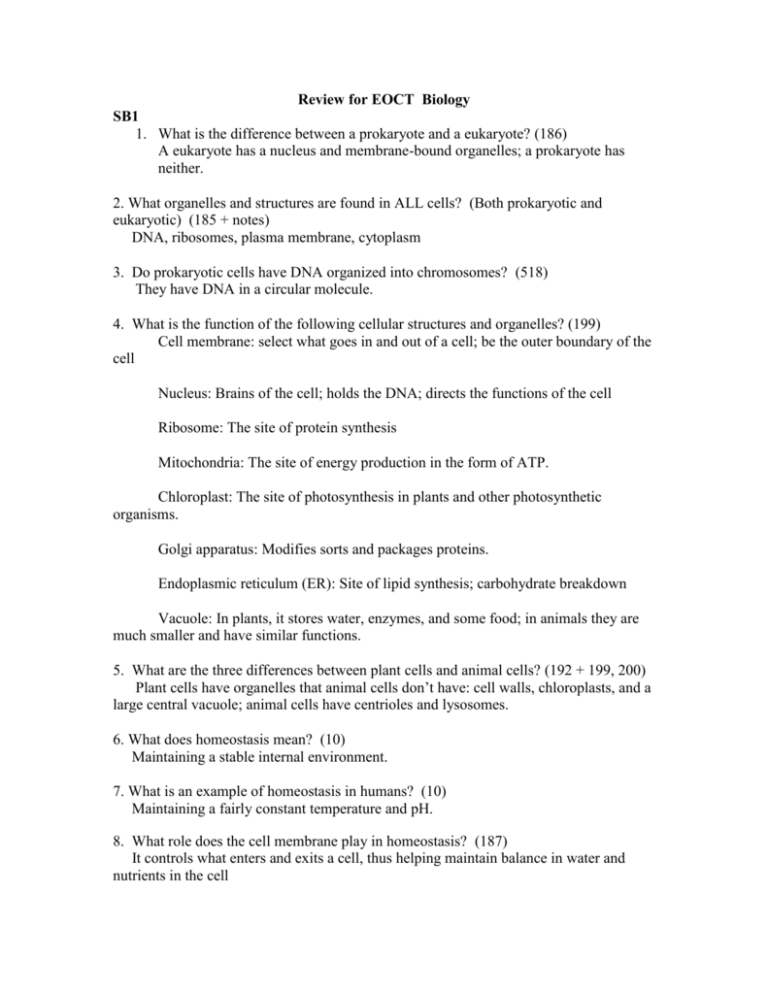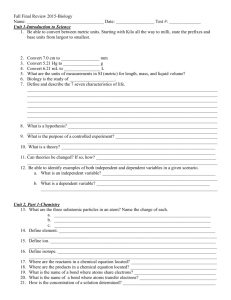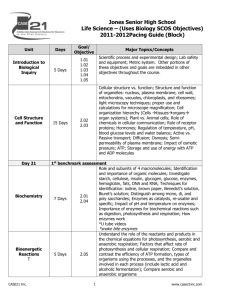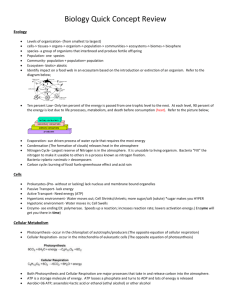Review for EOCT
advertisement

Review for EOCT Biology SB1 1. What is the difference between a prokaryote and a eukaryote? (186) A eukaryote has a nucleus and membrane-bound organelles; a prokaryote has neither. 2. What organelles and structures are found in ALL cells? (Both prokaryotic and eukaryotic) (185 + notes) DNA, ribosomes, plasma membrane, cytoplasm 3. Do prokaryotic cells have DNA organized into chromosomes? (518) They have DNA in a circular molecule. 4. What is the function of the following cellular structures and organelles? (199) Cell membrane: select what goes in and out of a cell; be the outer boundary of the cell Nucleus: Brains of the cell; holds the DNA; directs the functions of the cell Ribosome: The site of protein synthesis Mitochondria: The site of energy production in the form of ATP. Chloroplast: The site of photosynthesis in plants and other photosynthetic organisms. Golgi apparatus: Modifies sorts and packages proteins. Endoplasmic reticulum (ER): Site of lipid synthesis; carbohydrate breakdown Vacuole: In plants, it stores water, enzymes, and some food; in animals they are much smaller and have similar functions. 5. What are the three differences between plant cells and animal cells? (192 + 199, 200) Plant cells have organelles that animal cells don’t have: cell walls, chloroplasts, and a large central vacuole; animal cells have centrioles and lysosomes. 6. What does homeostasis mean? (10) Maintaining a stable internal environment. 7. What is an example of homeostasis in humans? (10) Maintaining a fairly constant temperature and pH. 8. What role does the cell membrane play in homeostasis? (187) It controls what enters and exits a cell, thus helping maintain balance in water and nutrients in the cell 9. How does the composition of the cell membrane contribute to the maintenance of homeostasis? (187, 188) It is composed of a phospholipid bilayer that only allows certain substances in and out, maintaining balance. 9. What is the process that eukaryotic cells use to divide their nucleus and therefore reproduce cells? (248) Mitosis 10. Under what circumstances do normal eukaryotic cells reproduce? (244, 245, 246 + notes) For repair, replacement, and growth. 11. What happens when normal cells have unregulated cell growth and reproduction? (254) Tumors are produced (cancer). 12. What is the purpose of enzymes? (159) To speed up chemical reactions. 13. What factors can influence the activity of enzymes? (160) Temperature and pH. 14. What are the functions of each of the following molecules in living organisms? (167) Carbohydrates: Short term energy storage Proteins: Transport, as enzymes to speed reactions, provide structural support, make hormones Lipids: Long term energy storage, provide barriers (such as cell membranes) Nucleic acids: Store and communicate genetic information 15. What is ATP and what does it do? (221) ATP is the energy molecule of the cell. 16. What is the difference between ATP and ADP? (221) Which one has the most energy? ATP has three phosphates and ADP has two phosphates. ATP holds more energy. 17. What is released when ATP becomes ADP? (221) Energy 18. What element is found in all organic molecules? (166) Carbon. 19. What four elements are the most common elements in living organisms (notes) Carbon, hydrogen, oxygen, and nitrogen 20. What is diffusion? (201) The movement of substances from an area of higher concentration to an area of lower concentration. 21. What is osmosis? (203) The diffusion of water across a selectively permeable membrane. 22. What happens when an animal cell is put in each of the following solutions? What happens when a plant cell is put into each of the following? (205, 205) Hypotonic: Water enters the cell and it will eventually burst. Hypertonic: Water will leave the cell and it will shrivel Isotonic: Water will both leave and enter the cell in equal amounts 23. What is the difference between active transport and passive transport? (205) Active transport requires energy to move substances against a concentration gradient; passive transport does not use energy, but may use transport Proteins. SB2 24. What are the components and structure of DNA? (329) DNA is composed of repeating units of nucleotides. Nucleotides are composed of a phosphate group, and 5-carbon sugar, and a nitrogen base. 25. What is the importance of the four nitrogen bases in DNA? (338) The order of the nitrogen bases determine what kind of protein a gene makes. 26. What are the differences between DNA and RNA? (336) DNA has the sugar deoxyribose, RNA has the sugar ribose. DNA use thymine to complement adenine, RNA uses uracil to complement adenine. DNA is double stranded and RNA is single stranded; DNA is confined to the nucleus, RNA is found in the nucleus and the cytoplasm. 27. What are the two roles of DNA in living cells? notes It holds the information for heritable traits, and it holds the information for making proteins. 28. Who was Gregor Mendel? (277) He was an Austrian monk who is considered the father of genetics. 29. What is the Law of Segregation? (279) Mendelian genetics law that states that during meiosis the two forms of each trait separate and are inherited separately. 30. How does meiosis relate to the Law of Segregation? (279) Alleles separate during meiosis. 31. How does the segregation of gametes during meiosis contribute to genetic variability? (279 + notes) Each form of each trait is separated into a particular gamete during meiosis and thus is inherited separately. 32. What is the Law of independent assortment? (280) Genes on separate chromosomes sort independently. 33. How does meiosis relate to the Law of Independent assortment? (280) This independent assortment happens during meiosis, the formation of gametes, 34. How does independent assortment contribute to genetic variability? (280, 283 + notes) With the genes on each chromosome inherited separately and randomly, genetic variability is increased. 35. What is a genetic mutation? (345) A change in the DNA of an organism. 36. How do mutations change the traits or characteristics of an organism? (346, 347) By changing the sequence of nucleotides in an organisms DNA, the proteins produced will be changed, and thus the characteristics will be changed. 37. What are the following mutations? (3460 Insertion: The adding of a nucleotide or nucleotides to the DNA nucleotide sequence of an organism Deletion: The taking away of a nucleotide or nucleotides from the DNA nucleotide sequence of an organism. Substitutions: One nucleotide (base) is exchanged for another. 38. What factors can cause a mutation? (348) A mistake in DNA replication; damage to DNA by certain chemicals, high energy forms of radiation (X-rays, gamma rays), and ultraviolet radiation. 39. In what environmental circumstances would asexual reproduction be favorable? notes Why? If the organism is very fit for its environment, then duplicating that organism by asexual reproduction is favorable. 40. In what environmental circumstances would sexual reproduction be favorable? notes Why? Sexual reproduction adds variation to the gene pool, so sexual reproduction would be beneficial in a changing environment. 41. How is DNA technology used in forensics? (detective work) (373) DNA can be used to trace a person’s DNA to a crime scene. 42. How can DNA technology be used in medicine? (378) It can be used to design drugs for medical use. Correcting mutations in DNA that cause disease or disorders is being tried. 43. How can DNA technology be used in agriculture? It can be used to cause pesticide resistance to a crop plant, so that weeds or insects can be killed more easily without hurting the crop plant; it can be used to increase yield of a crop; it can be used to cause plants to produce larger fruit or other parts that are eaten. SB3 44. What are the reactants in photosynthesis? (222) 6CO2 + 6H2O ( in the presence of sunlight) 45. What are the products of photosynthesis? (222) C6H12O6 + 6O2 46. What are the reactants of cellular respiration? (228) C6H12O6 + 6O2 47. What are the products of cellular respiration? (228) 6CO2 + 6H2O + ATP (energy) 48. How are cellular respiration and photosynthesis related to each other? (233) The products of one are the reactants of the other. The reactants of one are the products of the other. 49. What supplies the energy for photosynthesis? (222) The sun 50. Where is the energy stored in the products of photosynthesis? (222) In the chemical bonds of the sugars produced 51. What reactant of cellular respiration holds energy? (228) The glucose molecules 52. Into what molecule does the energy that is harvested during cellular respiration go? (228) ATP 53. Which kingdoms have prokaryotic organisms? (502) Archaebacteria and Eubacteria 54. What is the common name for prokaryotic organisms? (499) Bacteria 55. Which kingdoms have eukaryotic organisms? (502) Plants, animals, fungi, and protists 56. Which kingdoms have cells with cell walls and how do the cell walls differ between the kingdoms? (502) Bacteria (some have peptidoglycan in cell walls); plants (have cellulose in cell walls); fungi (chitin in cell walls), plant-like protists have cellulose in their cell walls. 57. Which kingdom has NO organisms with cell walls? (502) Animals 58. Which kingdoms have only multicellular organisms? (502) Plants and animals 59. Which kingdom has only unicellular organisms? (502) Archaebacteria and Eubacteria 60. Which kingdoms have both multicellular and unicellular organisms? (502) Fungi and protists 61. Which kingdom has cells that are external heterotrophs? (502) Fungi 62. Which kingdom has only multicellular autotrophic organisms? (502) Plants 63. Which kingdom has only multicellular autotrophic organisms? (502) Plants 64. Which kingdom has the “left-overs” of the other kingdoms? (502) Protista 65. How do taxonomic groups show evolutionary relationships? (Which groups are most closely related and which groups are most distantly related?) (487) The lower down on the taxonomic groupings (domain is highest, species is lowest), the closer the relation. 66. Are viruses considered to be living? Why or why not? (525) Viruses are not considered alive, because they don’t meet all the conditions necessary for life, like reproducing on their own. SB5 67. What is the definition of evolution? (422) Change in a population over time. 68. What was Lamark’s theory of how evolution occurs? notes The theory of acquired characteristics 69. Was Lamark correct? notes NO 70. What is Darwin’s theory of how evolution occurs? (420) By natural selection 71. What event in Darwin’s life caused him to formulate his theory? (418) His voyage around the world on HMS Beagle 72. What does biodiversity mean? (116) Variability in life forms 73. Why is biodiversity required for evolution to occur? notes (421) Without variability of traits there could be no natural selection of the best traits to survive and reproduce. 74. What is meant when two different species of animals have a common ancestor? notes Having an ancient related species 75. Does evolution occur steadily or does the rate of evolution change? (440) Evolution happens slowly and steadily until and if there is a sudden, great change in the environment. 76. What factors could influence the rate of evolution? (440) A co-evolutionary arms race, that is, two species that are predator and prey each change in response to each other (not intentionally). 77. How are fossils used to support the occurrence of evolution? (423) Change over time of a species can be seen in fossils. 78. How is molecular evidence used to support evolution? (427) DNA and proteins of species that are not closely related share the same sequences and they make the same proteins 79. What kind of molecular evidence is useful? (427) Evidence like the same gene making the same protein in unrelated species 80. What is natural selection? (420) The traits that give an organism an increased advantage in survival and reproduction get passed on to the next generation 81. How can natural selection cause the appearance of a new species? (420) If a population changes enough because of natural selection that it no longer can mate with the original population, then speciation has occurred. 82. Is evolution still happening? (429) Evolution is happening and will always happen. 83. What evidence do we have that evolution is still occurring? (429) New species are being discovered all the time. 84. Explain the role of natural selection in our current problem of antibiotic resistant bacteria. (429) Bacteria with a natural resistance to certain drugs are being naturally selected by the over-use of these particular drugs. SB4 85. Define the following terms, give an example of each, and put the following terms in order of the largest to the smallest – biome, biosphere, community, ecosystem, population, individual organisms, niche (37) Biosphere – The layer of earth that supports life from high in the atmosphere to deep in the ocean Biome – a group of ecosystems that share the same climate and have similar types of organisms Ecosystem – A biological community and all the abiotic factors that affect it Community – all the populations that live in the same place at the same time Population – a group of organisms of the same species living in the same place at the same time Organism 86. What is a food chain or food web? (43) A food chain is a model that shows how energy flows through and ecosystem. A food web is a complex system of food chains. 87. How does energy flow through an ecosystem? (42) Through a food chain or food web. 88. What kind of organism is always at the bottom of a food chain? (43) Autotroph/ usually a plant 89. What is a trophic level? (44) Trophic means energy. A trophic level is a step in a food chain 90. How much energy is transferred in each step of a food chain? (44) 10% of the energy below on the step below. 91. What is an energy pyramid? (44) An energy pyramid represents that is available to the next trophic level. 92. What is the difference between primary succession and secondary succession? (62, 63) Succession is the changes that occur in an ecosystem that occur when one community replaces another. Primary succession occurs on exposed rock with no topsoil. No organisms have previously lived there. Example would be on lava rock after a volcanic eruption. Secondary succession occurs when an ecosystem is disturbed such as by flood or fire. Organisms that previously lived there have been replaced and the replacement continues until there is a stable climax community. 93. What environmental changes can trigger primary succession? (62) Volcanic eruption, glacier melt 94. What environmental changes can trigger secondary succession? (63) Fire, flood, deforestation, farmland that is no longer being used. 95. How can an increase in a nutrient cause an algal bloom? (127) The nutrients will act to quickly increase growth. Excessive algae growth in a short period of time is called a bloom. 96. How can an algal bloom affect an aquatic ecosystem (called eutrophication)? (127) Eutrophication is a result of an alga bloom. When pollutants such as nitrogen and phosphorous get into a water-way the algae grow so fast they use up the oxygen supply. Other organisms in the water suffocate causing more decay and more depletion of oxygen. This causes the body of water to die; no organisms can live in it. 97. What is a limiting nutrient (factor) in an ecosystem? (61) The limiting nutrient or limiting factor is the biotic or abiotic factor that restricts the continuing growth of a population. Examples of limiting factors are food (biotic) and water (abiotic). The amount of food or water limits the number of individuals that can survive in that environment. 98. How does a limiting factor affect the carrying capacity of an ecosystem? (97) The carrying capacity is the number of individuals that can live in that ecosystem at that time. The carrying capacity is set by the limiting factor. When the upper limit is reached, the maximum population size is determined. 99. Why is it important to recycle matter within an ecosystem? (45) Matter includes nutrients. Nutrients are in limited supply so they must be recycled so that the ecosystem does not run out of a particular nutrient. 100. How is water recycled? (46) Water is recycled through precipitation and evaporation. It is also cycled through transpiration of plants and used by photosynthesis and released during cellular respiration. 101. How is carbon recycled? (47) carbon is recycled through photosynthesis using CO2 in the atmosphere to produce carbohydrates and cellular respiration using the carbohydrates and releasing the carbon as CO2. . 102. How does the burning of fossil fuels affect the carbon cycle? (47) Fossil fuels release CO2 that has been trapped in the fuel into the atmosphere 103. How is oxygen recycled? (47) Oxygen is released in photosynthesis and used in cellular respiration 104. How is oxygen recycling related to carbon recycling? (47) Both use photosynthesis and cellular respiration. 105. How is nitrogen recycled? (48) Nitrogen is recycled through bacteria. Bacteria decompose dead organisms and make the nitrogen available to plants through nitrogen fixation. The plants use the nitrogen to make proteins. Other organisms eat the proteins. Some nitrogen is released in urine which is also recycled by bacteria for plants to use. 106. What role do bacteria play in the recycling of nitrogen? (48) Nitrogen makes up about 70% of the atmosphere. Nitrogen fixing bacteria are the only organisms that can take the nitrogen form the air and make it available for plants to use. 107. How is phosphorous recycled? (49) Phosphorous is recycled through decomposers making it available to plants to use. Animals eat the plants. Other phosphorous comes from rocks wearing down and the plants using it. 108. What role do decomposers have in an ecosystem? (42) Decomposers recycle the nutrients. Without decomposers we would run out of nutrients. 109. What are some typical decomposers? (42) Bacteria and fungus. 110. What would happen if there were no decomposers on earth? (42) We would run out of resources and dead organisms and waste would build up. 111. What is the projection for human population growth and the effect of that growth? (102) Population growth is higher in less developed countries and lower in industrial countries. Overall, the world population continues to increase. 112. Are the earth’s water resources renewable? (130) yes 113. Are water resources threatened and how? (130) Pollution is threatening out water resources. 114. How can water resources be managed? (130) Pollution can be controlled and waste can be controlled. 115. How does pesticide use affect other species of animals? Pesticides kill insects. The poison can get into the food chain and damage other organisms that are higher on the food chain. 116. What is biological magnification? Biological magnification is when a pesticide or other pollutant gets into the food chain. The amount of the “poison” in the tissues of the animal becomes greater the higher the animal is on the food chain. 117. Do plants have special adaptations that allow them to live in particular environments or can any plant live anywhere? (evolution and tropisms) Give an example of each. (winter dormancy is one) Plants that live in the desert have the ability to store water. Seeds allow embryonic plants to survive the harsh conditions of winter or of a drought. Tropisms are a plants response to an environmental stimulus. Plants are phototropic meaning they grow towards light. They are gravitropic meaning the roots grow towards gravity and the shoots grow away from gravity. 118. Do animals have special adaptations that allow them to live in a particular environment or can they live anywhere? (evolution) (428) Give an example. Animals are adapted to their environment. Fish have gills and can live in the water. Mammals have hair to conserve heat and therefore maintain a relatively constant temperature. 119. Can the behavior of an animal be an adaptation to an environment? Give an example. Reptiles do not conserve their body heat, they have no insulation like feathers or fur. They need to be warm to digest their food or the enzymes will not work and the food will not be digested. Reptiles find a warm place after they have eaten, usually in the sun. 120. What does sustainable use mean? (130) Sustainable means that the resources can be replenished (recycled) at the same rate they are used, this conserves the resources over long periods of time.









